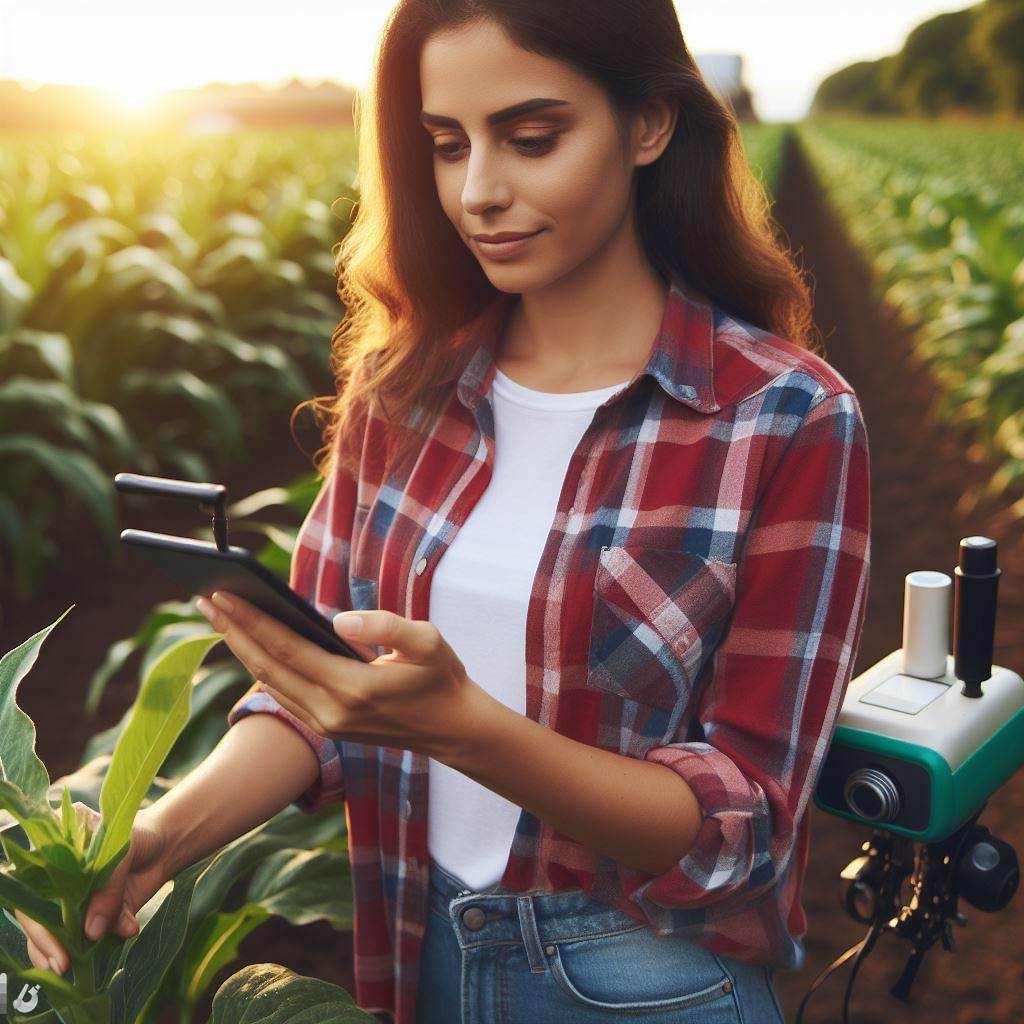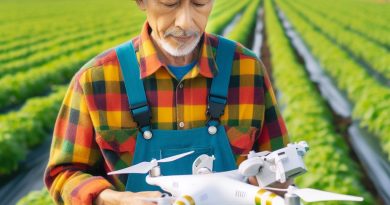Crop Monitoring: New Tech Insights
Last Updated on January 20, 2024
Introduction
Importance of crop monitoring
Crop monitoring plays a crucial role in modern agriculture as it allows farmers to assess crop health and optimize yields.
By closely monitoring crops, farmers can identify nutrient deficiencies, pest infestations, and disease outbreaks, enabling them to take timely action and prevent significant yield losses.
Overview of new technologies for crop monitoring
Advancements in technology have greatly enhanced crop monitoring capabilities.
New tools and technologies offer precise and real-time data, allowing farmers to make informed decisions and improve overall crop management.
For instance, drones equipped with high-resolution cameras can capture detailed images of crops from above.
This aerial imagery provides valuable insights into crop health, allowing farmers to detect issues that may not be apparent from the ground.
Satellite imagery is another powerful tool used in crop monitoring.
With the ability to capture images of vast areas, satellite data provides a comprehensive overview of crop health and helps identify areas that require attention.
Combined with advanced analytics, satellite imagery can also assist in predicting crop yield and assessing the impact of weather patterns on crops.
Sensor-based technologies are also gaining popularity in crop monitoring.
Soil moisture sensors, weather stations, and nutrient analyzers offer precise measurements, empowering farmers to optimize irrigation, fertilizer application, and other farming practices.
These technologies eliminate guesswork and enable farmers to implement precision agriculture techniques, reducing resource wastage and enhancing crop productivity.
Basically, crop monitoring is vital for modern agriculture, and new technologies are revolutionizing the way farmers monitor their crops.
By embracing these advancements, farmers can make informed decisions, improve crop health, and ultimately achieve higher yields.
Benefits of Crop Monitoring Technologies
Increased yield and better crop management:
Crop monitoring technologies provide real-time data on crop conditions, allowing farmers to make informed decisions. By monitoring plant health, farmers can identify any deficiencies or stress factors early on and take corrective actions.
Predictive analytics based on monitoring data can help optimize irrigation, fertilizer application, and overall crop management strategies.
Farmers can adjust their practices based on the data received, resulting in increased yield and improved crop quality.
Better crop management leads to reduced waste, saves resources, and maximizes profitability.
Early detection and prevention of pests or diseases
Crop monitoring technologies enable farmers to identify and monitor the presence of pests or diseases in real-time. By using sensors and satellite imagery, farmers can detect potential threats before they become widespread and cause significant damage.
Early detection allows farmers to implement targeted measures to control outbreaks and minimize crop losses.
Remote monitoring through drones or automated systems facilitates regular inspections across large areas, ensuring quick identification of any problems.
Timely intervention not only protects the current crop but also prevents future infestations, improving long-term crop health and reducing the use of chemical pesticides.
Optimization of resource usage
Crop monitoring technologies provide accurate data on soil moisture levels, helping farmers optimize irrigation practices.
Using sensors and weather data, farmers can schedule irrigation based on actual crop needs, reducing water wastage and improving water-use efficiency.
Real-time monitoring of nutrient levels in the soil allows farmers to apply fertilizers precisely where and when needed.
By avoiding over-fertilization, farmers can reduce nutrient runoff, minimize environmental impact, and save costs.
Optimizing resource usage leads to sustainable farming practices, conserves natural resources, and reduces the ecological footprint.
In short, crop monitoring technologies offer numerous benefits to farmers, including increased yield, better crop management, early detection and prevention of pests or diseases, and optimization of resource usage.
By harnessing the power of real-time data and advanced analytics, farmers can make informed decisions, protect their crops, and optimize their farming practices.
Adopting these technologies can lead to improved profitability, sustainability, and long-term success in the agricultural industry.
Read: Data Analytics in Modern Farming
Types of Crop Monitoring Technologies
Crop monitoring plays a crucial role in maximizing agricultural productivity and ensuring sustainable practices.
With advancements in technology, various tools and techniques have emerged for effective crop monitoring.
In this section, we will explore the different types of crop monitoring technologies.
Remote sensing
Satellite imagery
Satellite imagery is one of the most commonly used technologies for crop monitoring.
It involves capturing images of crops from satellites orbiting the Earth.
These images provide valuable information about crop health, growth patterns, and potential yield.
By analyzing satellite imagery, farmers can detect early signs of crop stress, nutrient deficiencies, or pest infestations.
This allows them to take timely and targeted actions to mitigate any potential risks and optimize crop production.
Drone technology
Drone technology has revolutionized crop monitoring by offering high-resolution images and more frequent monitoring capabilities.
Drones equipped with cameras and sensors can capture detailed images and collect data about crop health.
By flying over fields, drones provide a bird’s-eye view of the crops, allowing farmers to identify specific areas that require attention.
Drones also enable farmers to monitor larger areas quickly and efficiently, saving time and resources.
Sensor-based monitoring
Soil moisture sensors
Soil moisture sensors are essential tools for crop monitoring as they help farmers determine the optimal irrigation schedule for their crops.
These sensors measure the moisture content in the soil, allowing farmers to understand how much water is available for the plants.
By accurately assessing soil moisture levels, farmers can avoid overwatering or underwatering their crops, thereby optimizing water usage and preventing water-related issues such as water stress or nutrient leaching.
Weather stations
Weather stations provide real-time data on weather conditions, including temperature, humidity, wind speed, and rainfall.
This information is crucial for crop monitoring as it helps farmers make informed decisions about planting, harvesting, and applying pesticides or fertilizers.
By monitoring weather conditions, farmers can anticipate potential risks such as frost, drought, or heavy rainfall and take necessary precautions to protect their crops.
Plant health sensors
Plant health sensors monitor the overall health and growth of plants by measuring various parameters such as chlorophyll levels, leaf thickness, and canopy temperature.
These sensors can detect early signs of plant diseases, nutrient deficiencies, or pest infestations.
By identifying problems at an early stage, farmers can intervene promptly, preventing the spread of diseases and minimizing the use of chemicals.
Essentially, crop monitoring technologies have significantly advanced in recent years, providing farmers with valuable insights to improve their agricultural practices.
Remote sensing, through satellite imagery and drone technology, offers detailed and timely information about crop health and growth patterns.
Sensor-based monitoring, including soil moisture sensors, weather stations, and plant health sensors, enables farmers to make informed decisions regarding irrigation, pest control, and overall crop management.
By harnessing these technologies, farmers can optimize their crop production, minimize risks, and contribute to sustainable agriculture.
Read: Water Tech in Controlled Ag Environments
Application of Crop Monitoring Technologies
Crop growth monitoring
One of the key applications of crop monitoring technologies is in monitoring crop growth.
These technologies provide real-time data on plant health, growth rate, and development stages.
By analyzing this data, farmers can make informed decisions regarding fertilization, pest control, and harvesting timings.
This helps optimize crop productivity and ensure maximum yield.
Disease detection and prevention
Crop monitoring technologies also play a crucial role in disease detection and prevention.
These technologies use sensors and remote sensing techniques to identify signs of diseases and pests.
Farmers can receive alerts and warnings when an outbreak is detected, allowing them to take immediate action.
Early detection helps prevent the spread of diseases and minimizes crop damage.
Weed management
Weed management is another area where crop monitoring technologies prove beneficial.
These technologies help identify weed infestations and their precise locations in the fields.
Farmers can then use targeted herbicide applications or implement mechanical weed control methods only where necessary.
This reduces the reliance on chemical herbicides and saves time and resources.
Irrigation management
Efficient irrigation management is crucial for optimal crop growth and water conservation.
Crop monitoring technologies aid in managing irrigation by providing accurate information on soil moisture levels.
Using this data, farmers can determine when and how much water to apply to crops, ensuring that they receive the right amount at the right time.
This minimizes water wastage and improves water use efficiency.
In general, crop monitoring technologies have a wide range of applications in agriculture.
From monitoring crop growth to detecting and preventing diseases, managing weeds, and optimizing irrigation, these technologies revolutionize farming practices.
By harnessing the power of real-time data and advanced analytics, farmers can make more informed decisions and enhance crop productivity while minimizing resource wastage.
The continuous development and adoption of crop monitoring technologies will play a key role in ensuring global food security and sustainable agricultural practices in the future.
Read: Soil Health: Tech’s Role in 2024
Challenges and Limitations
Cost of implementing new technologies
- The implementation of new technologies for crop monitoring can be costly for farmers and agricultural businesses.
- High expenses include the purchase of equipment, software, and training for employees.
- Additionally, maintenance and upgrading costs add to the financial burden.
- Small-scale farmers may find it difficult to afford such investments, limiting their access to advanced monitoring technologies.
Limited access to technology in certain regions
- In remote or underdeveloped regions, the lack of infrastructure and internet connectivity can hinder the adoption of crop monitoring technologies.
- This digital divide creates disparities in accessing real-time monitoring and data analysis.
- Farmers in these areas may rely on traditional methods, which are less accurate and efficient.
- Governments and organizations need to address this issue and provide support to bridge the technology gap.
Integration and interpretation of data
- The vast amount of data generated by crop monitoring technologies can be overwhelming and challenging to handle.
- Integrating data from different sources, such as sensors, satellites, and weather stations, requires sophisticated data management systems.
- Interpreting the data also requires technical expertise to make informed decisions for crop management.
- A lack of data analysis skills can lead to inefficient use of the collected information, reducing the potential benefits of crop monitoring technologies.
Despite these challenges and limitations, the advancements in crop monitoring technologies offer significant opportunities for agriculture.
Overcoming the obstacles
Efforts are being made to overcome these obstacles and make these technologies more accessible and affordable.
Various initiatives are promoting capacity-building and knowledge transfer to ensure that farmers can effectively use these tools.
Collaboration between research institutions, governments, and the private sector is crucial to address the challenges and find innovative solutions.
Investments in infrastructure and connectivity are needed to extend the reach of these technologies to remote areas.
Additionally, training programs and educational resources can equip farmers with the necessary skills to interpret and utilize the data gathered.
By addressing these challenges, crop monitoring technologies can contribute to sustainable agriculture, increased productivity, and food security.
Farmers can make data-driven decisions, optimize resource allocation, and mitigate risks associated with climate change and pest infestations.
Ultimately, the integration of new tech insights in crop monitoring has the potential to revolutionize the agricultural industry and pave the way for a more efficient and sustainable future.
Read: Sustainable Ag Tech: What’s New?

Case Studies on Successful Implementation
In this section, we will explore two case studies that demonstrate the successful implementation of crop monitoring technologies.
Improved Crop Yield through Remote Sensing
One prime example of the positive impact of crop monitoring technology is evident in a case study focusing on improved crop yield through remote sensing.
The Challenge
A farmer in a developing country was struggling with low crop yield and was unable to identify the underlying issues affecting the productivity of the crops.
The Solution
The farmer decided to implement a remote sensing technology.
This involved using satellite imagery to monitor the crops from a distance.
The Implementation
The farmer worked with a team of experts who analyzed the satellite imagery to identify crop health, nutrient deficiencies, and water stress.
The Results
By using the insights gained from remote sensing, the farmer was able to take targeted actions such as adjusting irrigation, applying appropriate fertilizers, and managing pests.
This led to a significant improvement in crop yield, resulting in increased profits and enhanced food security in the region.
Effective Pest Management with Sensor-Based Monitoring
Another compelling case study showcases how sensor-based monitoring can revolutionize pest management practices.
The Challenge
A large-scale farmer was facing significant crop damage due to pest infestations and was struggling to manage them effectively.
The Solution
The farmer decided to incorporate sensor-based monitoring systems that could detect pests’ presence in the fields.
The Implementation
Various types of sensors, including pheromone traps and plant health monitors, were strategically placed across the fields to capture real-time data.
This data was then analyzed using advanced algorithms and machine learning techniques to identify pest patterns and potential outbreaks.
The Results
With the help of sensor-based monitoring, the farmer was able to implement targeted pest management strategies at the right time.
This significantly reduced crop damage, minimized pesticide use, and saved costs, ultimately resulting in higher yields and increased profitability.
These two case studies illustrate the power of crop monitoring technologies in improving crop yield and pest management.
By leveraging remote sensing and sensor-based monitoring, farmers can make data-driven decisions that optimize resource utilization, reduce environmental impact, and enhance overall agricultural productivity.
As technology continues to advance, it is crucial for farmers and agricultural stakeholders to embrace these innovations to overcome the challenges faced in crop monitoring.
With the right tools and strategies in place, farmers can effectively monitor their crops, make informed decisions, and contribute to a more sustainable and food-secure future.
Read: Automation in Agriculture: Pros & Cons
Future Trends and Possibilities
Artificial intelligence and machine learning in crop monitoring
- Artificial intelligence (AI) and machine learning algorithms hold immense potential for improving crop monitoring.
- AI-powered solutions can analyze vast amounts of data, enabling real-time identification of crop health issues.
- Machine learning algorithms can learn from past data to predict future crop health conditions accurately.
- By analyzing various data inputs, AI can provide farmers with valuable insights and recommendations for optimal crop management.
- AI can detect early signs of diseases, pest infestation, nutrient deficiencies, and other crop stress factors.
- This technology allows farmers to take proactive measures, preventing significant crop damage and enhancing overall yield.
- AI-based crop monitoring systems can also automate data collection and streamline the decision-making process.
Integration of cloud-based platforms for data analysis
- Cloud-based platforms offer a scalable and accessible solution for analyzing vast amounts of crop monitoring data.
- By leveraging cloud computing, farmers can store, process, and analyze data from multiple sources.
- Cloud platforms provide real-time data updates, enabling farmers to monitor their crops remotely.
- These platforms also enable seamless integration with other technologies, such as IoT devices and drones.
- Farmers can visualize and interpret the analyzed data through user-friendly dashboards and mobile applications.
- Cloud-based platforms foster data sharing and collaboration among farmers, researchers, and agricultural experts.
- This integration allows for collective insights and improved decision-making for sustainable crop management.
Collaborative efforts and knowledge sharing in the agricultural community
- Collaboration and knowledge sharing among farmers, researchers, and experts are crucial for advancing crop monitoring.
- Farmers can collectively share data, experiences, and best practices, leading to improved crop management strategies.
- Online communities and forums can facilitate the exchange of ideas and solutions for common challenges.
- Collaborative efforts can help identify emerging trends and optimize crop monitoring techniques.
- Sharing knowledge about successful crop monitoring techniques can benefit farmers worldwide, especially in developing regions.
- Government agencies, NGOs, and private organizations can play a vital role in fostering collaboration and knowledge sharing.
- By working together, the agricultural community can harness the power of technology to ensure sustainable and efficient crop monitoring.
In essence, the future of crop monitoring looks promising with the advent of artificial intelligence, machine learning, and cloud-based platforms.
These technologies can revolutionize the way farmers manage their crops, leading to better yields and sustainable farming practices.
Collaborative efforts and knowledge sharing within the agricultural community will further enhance these advancements, ensuring that crop monitoring becomes more accessible and effective for farmers worldwide.
Conclusion
Crop monitoring technologies offer numerous benefits for farmers, including increased efficiency and reduced costs.
These technologies also have future possibilities for further advancements in crop management.
It is crucial for farmers to embrace new technologies to stay competitive and improve their crop yields.
By using crop monitoring tools, farmers can gain valuable insights into the health of their crops and make informed decisions.
This can lead to better resource allocation, timely interventions, and ultimately, improved profitability.
Additionally, the use of these technologies can help mitigate the negative impacts of climate change on crop production.
Farmers are encouraged to invest in crop monitoring technologies to optimize their farming practices and yield higher-quality crops.
The integration of these technologies with precision agriculture techniques can revolutionize the farming industry.
It is vital for farmers to keep up with the rapidly evolving field of crop monitoring and adopt new technologies.
By doing so, they can ensure the sustainability and productivity of their farms in the face of challenges posed by climate change and global food demand.
In a nutshell, crop monitoring technologies provide farmers with powerful tools to enhance their crop management practices and secure a prosperous future in agriculture.


